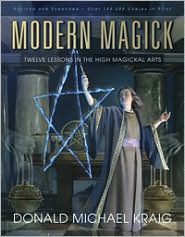Ceremonial magicians alert: the Mothership has landed again. This third edition of Don Michael Kraig’s massive tome offers a highly structured, progressive education in ritual magic that involves a great deal of discipline on the part of the would-be practitioner. The lessons are (more or less) transcripts of his classes on ceremonial magick, and this gives the writing a personal touch. There are absolutely NO secrets here – no blinds, confusing instructions in archaic language, or mysterious lists of ingredients with unknown modern equivalents. Kraig has made every effort to keep it real, but that isn’t the same as making it easy.
The book’s subtitle suggests that there are twelve lessons given here, and that’s a bit misleading. Each “lesson” is a chapter designed around a central concept and skill, supplemented with copious related information about tools, elements, mental conditioning and specific rituals. The first six lessons supply basic “outer order” working knowledge of rituals and the occult underpinnings that fuel them; the final six lessons go into deeper “inner order” aspects of ritual magick.
This is a conservative, gradual program that aims toward personal as well as magickal mastery. The skills given in each lessons are developed through daily ritual practice, and progress is tracked with a diary-journal for rituals, dreams, tarot readings and other experiences. Short-cuts are discouraged, and there are warnings about dangerous pitfalls along the way. There are anecdotes about magicians who strayed and ended up in the metaphysical gutter. Ethics, motivations and intentions are subjected to keen scrutiny, and they should be. Magick done badly or for the wrong reasons can have horrible consequences for the practitioner and innocent bystanders.Rituals are outlined and described in great detail. There are plenty of illustrations and diagrams to show exactly how to set up an altar, create magical tools, and perform the body stances used in the rituals. Each chapter ends with review questions and a bibliography suggesting texts to augment understanding of concepts and practices. The rituals are rooted in what Kraig calls the WASP Kabala (i.e., White Anglo-Saxon Protestant): a form of universalized Hebrew mysticism grafted to the core of Western magical systems during the Middle Ages. Much of this is based on the work of the Hermetic Order of the Golden Dawn, although Kraig’s version is much more digestible by modern readers.
The rituals are reliant on Hebrew letters, words and Kabalistic concepts. If the reader doesn’t feel a genuine connection to the Kabala, or is jarred by the ubiquitous Hebrew in the rituals, it is unlikely that much will be gained from this text. Kraig does suggest the possibility of experimenting with alternatives, but without an advanced grasp of an alternate metaphysical core, that suggestion is unrealistic.
The advanced lessons (7 through 12) tackle complex workings in ceremonial magick, including talismans, sex magick, astral projection, and evocation of spirits. The content for talismans and spirit evocations is derived from old grimoires and detailed procedures are given for performing the procedures. The section on talismans is disappointing. Kraig’s knowledge of geomancy and the astrological requirements for talisman construction is frankly inadequate, and the supplemental texts show why this is the case. In this specific area, Kraig is hindered by his adherence to sources dependent on the Kabala; most if not all medieval magicians were talented astrologers. Most readers won’t be impacted by this underwhelming lack, but there’s much more to the art of talismans than is given here. A subtle theme underlying the text is Kraig’s low expectations for ceremonial magicians to be multi-disciplinary. He cites the excuse that covens tend to have people who specialize in different areas so no one has to learn them all. Crowley and other notable magicians evinced a high level of expertise in multiple skill sets, and their heads didn’t explode. So it is possible (if not commonplace) to have more than a narrow grasp of ceremonial magick at one’s disposal.
The scope of this book is huge, and be warned – it is not a page turner. Reading this book requires patience, discipline and deep thought, especially if the reader is working through the lessons at the pace recommended by the author. This edition contains four forewords, prefaces to the second and third editions, the twelve lessons (chapters), five appendices that include a glossary and an annotated bibliography, an index and a partridge in a pear tree. Through generous formatting and its exhaustive content, the book is massive.
Modern Magick is a thorough investigation and explication of ceremonial magick, and is definitely not for wimps, slackers, or wanna-be’s with little preparation for effort at this level. The deep involvement in the occult and ceremonial magick outlined in these lessons requires dedication, mental and emotional stability, and rugged endurance. Lessons and study groups are not always readily available, but for most people a support system would be helpful for continuity and discussion as milestones are reached. This book is recommended for readers with enough discipline and motivation to tackle the rigorous demands for self-development and daily practice outlined in the lessons.
~review by Elizabeth Hazel
Author: Donald Michael Kraig
Llewellyn, 2010
524 pp, $29.95
Modern Magick: Twelve Lessons in the High Magickal Arts, Third Platinum Edition
©
2010 - 2025
Facing North

